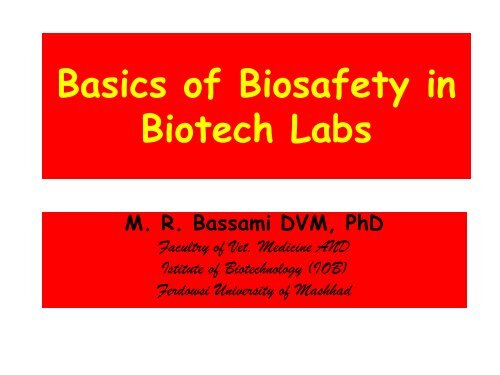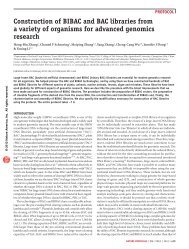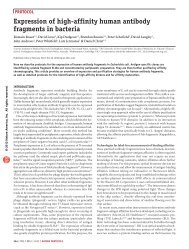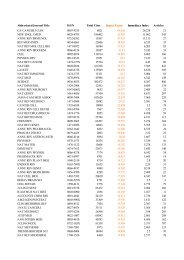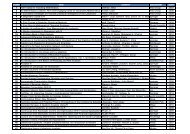Basics of Biosafety in Biotech Labs
Basics of Biosafety in Biotech Labs
Basics of Biosafety in Biotech Labs
You also want an ePaper? Increase the reach of your titles
YUMPU automatically turns print PDFs into web optimized ePapers that Google loves.
<strong>Basics</strong> <strong>of</strong> <strong>Biosafety</strong> <strong>in</strong><strong>Biotech</strong> <strong>Labs</strong>M. R. Bassami DVM, PhDFacultry <strong>of</strong> Vet. Medic<strong>in</strong>e ANDIstitute <strong>of</strong> <strong>Biotech</strong>nology (IOB)Ferdowsi University <strong>of</strong> Mashhad
اتفبق یه ثبر رخ ًوی زّس.اتفبق هی تَاًس هىزرا رخ زّس.هوىي است اتفبق اٍل ذتن ثِ ذیز ضَز.•••هوىي است اتفبقضَز. ثِ ذیز زٍم ذتن•هوىي است اتفبقضَز. ذتن ثِ ذیز سَم•هوىي است اتفبقضَز. ذتن ثِ ذیز چْبرم•هوىياست اتفبقضَز. ذتن ثِ ذیز پٌجن•• اتفبق ضطن چطَر؟
اتفبق یه لحظِ، ػَالتّز لحظِ اتفبق
Overview• Risk assessments• Risk Groups (RGs)• <strong>Biosafety</strong> levels (BSL-1 through BSL-4)• Personal protective equipment (PPE)• Conta<strong>in</strong>ment equipment• Aerosol-generat<strong>in</strong>g activities• Hazard communication• Emergency response & Spill response• Dis<strong>in</strong>fection/disposal• Specialized biosafety topic
Risk Assessment• Identify hazard (materials and procedures)• What might happen?• How likely is it to happen?• How serious are the consequences?• Identify possible exposures (who and how).• Consider <strong>in</strong>teractions <strong>of</strong> materials, procedures,facilities, and personnel.• Use procedures that reduce the risk.• Consider worst case scenarios.• Try to understand the risk.
Tools for Risk Assessment• Guidance documents• Risk group def<strong>in</strong>itions• Risk group lists
References - Risk Assessment<strong>Biosafety</strong> <strong>in</strong> Microbiological and Biomedical Laboratories(BMBL) 5 th EdNIH Guidel<strong>in</strong>es for Research Involv<strong>in</strong>g rDNANIHGuidel<strong>in</strong>esforResearchInvolv<strong>in</strong>grDNATwo Fudamental Documents for <strong>Biosafety</strong> <strong>in</strong> <strong>Biotech</strong>nology Laboratory
Additional References
More References• Biohazard Recognition and Control (BRCManual)• Biological Material Safety Data Sheets, HealthCanada• The Bad Bug Book, FDA• Emerg<strong>in</strong>g Infectious Diseases, CDC• Morbidity & Mortality Weekly Report, CDCAll References are available <strong>in</strong> the <strong>in</strong>ternet.
Risk groups• “Risk groups” are a system for categoriz<strong>in</strong>g thehazard posed by a microbe, which correspondto recommended precautions andconta<strong>in</strong>ment (biosafety levels) to protectaga<strong>in</strong>st those hazards.
Risk Group 1• RG1 (a larg number to be listed):– Agents associated with disease <strong>in</strong> healthy adult humans• Examples <strong>in</strong> <strong>Biotech</strong>-related labs:– E. coli (nonpathogenic laboratory stra<strong>in</strong>s)– Saccharomyces cerevisiae– Agrobacterium tumefaciens (plant bacterium)– Baculovirus (<strong>in</strong>sect virus)– Duck hepatitis B virus (avian virus)• Increased Precautions: RG1 modified to alter the host rangeor express oncogenes used for transfection.• Such foreign genes may be delivered <strong>in</strong>to your cell s andgenome
Risk Group 2• RG2:– Agents associated with human disease– rarely serious– preventive or therapeutic <strong>in</strong>terventions available• Examples:– E. coli (pathogenic stra<strong>in</strong>s)– Adenovirus (used as rep-deficient viral vector)– Moloney mur<strong>in</strong>e retrovirus, amphotropic– Herpes simplex virus (used as rep-deficient viral vector)– Chicken pox“Ecotropic Pathogens”“Amphotropic Pathogens”
cont.• “Ecotropic” viruses <strong>in</strong>fect only specific host species.• “Amphotropic” viruses can <strong>in</strong>fect multiple species<strong>in</strong>clud<strong>in</strong>g humans.• Modify<strong>in</strong>g the envelope prote<strong>in</strong>: extend host range<strong>of</strong> some viral vectors• Ecotropic mur<strong>in</strong>e retrovirus is RG1 while anamphotropic mur<strong>in</strong>e retrovirus is RG2.
cont.Rep-deficient viruses recomb<strong>in</strong>ation Rep-competent virusesdeliver genesReplication-deficient retroviruses Integrate Genome
Risk Group 3RG3:– serious or lethal human disease– prevention or therapeutics may be available– high <strong>in</strong>dividual risk, low community riskExamples:– Francisella tularensis– HIV– Histoplasma capsulatum– Mycobacterium tuberculosis
Risk Group 4• RG4:– cause serious or lethal disease– No prevention or therapeutics– high <strong>in</strong>dividual risk, high community risk• Examples:– Ebola virus– Herpes B virus– Lassa fever virus
Pathogen Characteristics• Route <strong>of</strong> transmission (determ<strong>in</strong>e BSL, PPE,…)• Infectious dose• Host Range• Vector• Stability <strong>in</strong> environment• Virulence• Toxicity• Concentration- Volume• Local vs Systemic
Transmission Routes• Aerosol, <strong>in</strong>halation• Fecal - oral• Vector e.g., mosquito• Cuts, scratches, bites• Percutaneous (needle)• Mucosal contact (splash)
Infectious Dose (ID50)• M. tuberculosis• Salmonella typhi• Listeria• Cryptosporidium• Rotavirus• Vibrio cholera10 cells100,000 cells< 1,000 cells< 10 cells10-100 i.u.1,000,000 cellsLethal Dose (LD50)• Botul<strong>in</strong>um neurotox<strong>in</strong> few ng
Host Susceptibility• Age• Immune competence• Medication• Nutritional status• Pregnancy• Metabolic disorders• Malignancy• Vacc<strong>in</strong>ation status
Precautions• Practices plus Physical Conta<strong>in</strong>ment– BSL1- RG1– BSL2 - RG2/BBP (bloodborn pathogen)/PIM (potenrially<strong>in</strong>fectious materials)– BSL3 - RG3– BSL4 - RG4• Risk group: start<strong>in</strong>g po<strong>in</strong>t to choose suitable biosafetylevel• Based on nature <strong>of</strong> the experiment: Precautionsor
Precautions• Primary human cells (BSL2: BBP)• Established human and monkey cells (BSL2:PIM)• Foreign plant pathogens (BSL2 or BSL3)• Herpes B virus (RG4)– cultures <strong>of</strong> Herpes B (BSL4)– not <strong>in</strong>tentionally <strong>in</strong>fected Specimen (BSL2)
<strong>Biosafety</strong> Level 1Good Microbiological Practices• No eat<strong>in</strong>g, dr<strong>in</strong>k<strong>in</strong>g, apply<strong>in</strong>g makeup, etc.• No mouth pipett<strong>in</strong>g• Safety glasses worn• Lab coat, sometimes gloves worn – leave <strong>in</strong> lab• Wash your hands – contact time critical• Safe handl<strong>in</strong>g <strong>of</strong> sharps• Hazard communication - especially forimmunocompromised personnel
<strong>Biosafety</strong> Level 1Facility Requirements• Ventilation: Negative air pressure, laboratorydoor closed• Limited Access to laboratory• Decontam<strong>in</strong>ate cultures and waste• S<strong>in</strong>k <strong>in</strong> each lab• accessible Eyewash• Surfaces impervious, cleanable
How Does <strong>Biosafety</strong> Level 2(BSL-2) Differ From BSL-1?• Standards more str<strong>in</strong>gent (facilities eg BSC and procedure)• Hazard Communication:– Tra<strong>in</strong><strong>in</strong>g (Pathogen specific)– Biohazard signage on doors• Entry restrictions: for some pathogens and susceptible populationat risk• Conta<strong>in</strong>ment: Aerosol-generat<strong>in</strong>g activities• Enhanced PPE: gloves, lab coats, safety glasses; sometimesrespirators• Enhanced sharps: precautions or no use• Decontam<strong>in</strong>ation: for specific pathogen (organized disposal)• Exposure response plan and Spill protocol for the hazard
When Is BSL-2 Appropriate?• Most RG2 agents <strong>in</strong> BSL2– some <strong>in</strong> BSL1 (attenutated <strong>of</strong> mitigat<strong>in</strong>g factors)– BSL3 (manipul virulence or tox<strong>in</strong> genes or oncogenes)• Viral Vectors, <strong>in</strong>clud<strong>in</strong>g replication-deficient, if<strong>in</strong>fects humans• Primary Human (some monkey) cells/tissues (BBP)• Established Human (some monkey) cells (PIM)• Animals receiv<strong>in</strong>g the above materials
Personal Protective Equipment• Lab coat/smock(PPE)• Eye protection (Safety goggles and full-faceprotection)• Coverall, booties, hair cover (<strong>in</strong> animal exp.)• Gloves (type), double gloves, freq. change• (some cases)• Respiratory (<strong>in</strong> some cases, if aerosolgenerat<strong>in</strong>gactivities not done <strong>in</strong> conta<strong>in</strong>ment)
Know how to remove your gloves!Latex gloves (Allergies: glove l<strong>in</strong>ers )
Wash your hands!!!Hand Hygiene ():• easiest• most effective• prevent lab-acquired <strong>in</strong>fectionsWash hands: take only 20-30 seconds
Respiratory ProtectionTypes <strong>of</strong> Respirators: different filter<strong>in</strong>g abilities• Surgical or dust mask - large particle• Chemical mask - vapor, acid• HEPA filtered facepiece* - microbes(N95 mask, N100 mask, PAPR*)Fit test: facial hair, glasses, head size and shape affectrespirator fitMedical evaluation to wear respirator*High efficiency particulate air (HEPA) filtration*PAPR - powered air purify<strong>in</strong>g respirator
سناریو های فرضی• در موارد فرضی ذیل تصمیم شما چیست؟• آیا موردی برای نگرانی شما وجود دارد؟• در این موارد چکار می کنید؟
سٌبریَ یه :تَصیِ ضوب چیست؟آلبی سیستؼلی ایوي گزیش زر آسهبثطگبُ هَلىَالر ثیَلَصی زرگیز وبر پبیبى ًبهِ ذَزهی ثبضس. ایطبى یه ویت ٍوتَر ٍیزٍسی سفبرش هی زّس )الجتِ ثب گزفتبریاست. ثِفزاٍاى(. ٍوتَر ٍیزٍسی فبلس لسرت تىثیزّویي زلیل ایطبى سطح ایوٌی BSL1 را اًتربة وززُ ٍ ػولیبت آسهبیطگبّیرا زًجبل هی ًوبیس.پبیِآیب تصوین ایطبى جبیشُ ًَثل را ثزای ایطبى ثِ ّوزاُ ذَاّس زاضت؟ثزای استبز راٌّوبی ایطبى چطَر؟تَصیِ ضوب چجست؟ ثزای تَصیِ ای ذساپسٌساًِ )وِ حسالل ثِ فبرؽ التحصیلیایطبى زر سبل 1404 هٌجز ضَز( چِ اطالػبتی را اس آلبی ایوي گزیش سئَال هیًوبییس؟(replication-deficient)(basic safety practices)••••
سئَاالتی وِ ثبیس ثپزسیس:• Ecotropic <strong>of</strong> amphotropic?• Infect human?• Replication-deficient or replication-componentvirus (RCV)?• Foreign gene to be cloned?• Integration <strong>in</strong>to the genome?• pathogenicity <strong>of</strong> replication-deficient vector (eyedamage by adenoviruses)?• Approval needed?
سٌبری2َ:تَصیِ ضوب چیست؟ذبًن سالهت پزّیش زر راستبی اًجبم پبیبى ًبهِ ذَز پزٍتىل جسیسی راهطبلؼِ هی وٌس ٍ ذَضحبل اس ایٌىِ ّوِ هَاز ٍ هؼزف ّبی السم زرآسهبیطگبُ ٍجَز زارز. تصوین هی گیزز ثسٍى اطالع هبله ثالهٌبرع ٍوتَرٍثزٍسی ٍ تزویت ضیویبیی سیىلَفسفبهیس آسهبیص را اًجبم زّس.تٌجلؼلی اس ّوىالسی ّبی آسهبیطگبّی ّبی اس راُ هی رسس ٍ فزیبزیاس تِ زل، ووی اس تِ زل( هی وطس وِ زاری چىبر هی وٌی؟فىز هی وٌیس فزیبز-فزهبیص ایطبى چِ ثَز؟ًِ(ذَة ًظز ضوب چیست؟ هَاظت ثبضیس ذبًن سالهت پزّیش ثزای زفبع 5سبل ثیطتز فزصت ًسارًس. ضوٌٌب ضَّز ّن ًفزهَزُ اًس.••••
سئَاالتی وِ ثبیس ثپزسیس:• Take time to plan the experiment out• Any experience?• Similar procedures done <strong>in</strong> the lab before?• Safety materials and procedures <strong>in</strong> place• Hazard communication <strong>in</strong> place?• Disposal procedures <strong>in</strong> place?• Exposure response plan and spill protocolavailable <strong>in</strong> lab?• Lab-specific tra<strong>in</strong><strong>in</strong>g on hazardous materials ?
سٌبریَ 3 :اضىبل زر چیست؟صفزللی سالهت ستیش ثز اسبس ایٌىِ زٍس ػفًَی سبلوًَال تیفی100.000 هَریَمآسهبیطگبُ( ایوٌی سطح1ثبوٌزی هی ثبضس، وبرش را زر آسبیطگبُ )هی ثرطیسزاًطىسُ زاهپشضىی ضزٍع هی ًوبیس.الجتِ ایي ثبر ثب استبز راٌّوبیص زوتز ثبسبهی لجال هطَرت ّبیالسم را هی وٌس ٍ وبهال ارضبز هی ضًَس )ّسف جبیشُ ًَثل هطتزن(•ًظز ضوب چیست؟ هٌظَرم ّسفِ ست.وَچیه وِ ًیس؟(•
پبسد• ID50 is only one factor <strong>in</strong> determ<strong>in</strong><strong>in</strong>g:– risk group– biosafety level• Concentrated cultures• High volume• Aerosol-generat<strong>in</strong>g procedures with cultures• All <strong>of</strong> these factors elevate the hazard level and need to be part <strong>of</strong>the risk assessment.• Salmonella typhimurium:– RG2 organism– Need BSL-2
سٌبریَ 4: اضىبل زر چیست؟ذبًن ثال پززاس تحت زرهلي ثب زارٍیی است وِ سیستن زفبػی ثسى را تبحسی تضؼیف هی وٌس. ثسٍى ایٌىِ آگبّی السم را زر ایي ذصَظ زاضتِثبضس. استبز راٌّوبی ایطبى ّن زوتز ثبسبهی است. وسبلتص را ثِ ایطبىاػالم هی وٌس. جٌبة زوتز اثتسا زلطبى ثِ رحن هی آیس زلی ثِ ًبگبُ ّسفجبیشُ ًَثل هطتزن ثِ یبز هجبروطبى ذطَر هی وٌس ٍ هربلفت ذَز را ثب ثِتؼَیك اًساذتي وبر اػالم هی فزهبیٌس.ًظز ضوب چیست؟ هٌطَرم ایي است وِ ذبًن ّب چزا ثِ زالیل ٍاّی اس سیزوبر زر هی رًٍس.••
پبسد• Risk <strong>of</strong> immunocompromisation• Supervisor assign her to other dutiesSupervisors sometimes
سٌبریَ 5-تَصیِضوب چیست؟ثز اسبس MSDS تَصیِ ضسُ ثزای ارگبًیسوی وِ ثب آىوبر هی وٌیس اس ػیٌه ایوٌی استفبزُ ضَز. چَى ػیٌه ایوٌیًساریس هججَریس اس ػیٌهReybanذَز استفبزُ وٌیس. هیشاىایثبر ذَزتبى را گش فزهبییس )راٌّوبیی: اس ذَز گذضتگی ثبثتاحتوبل آسیت ثِ ػیٌهReybanهٌظَر ًظز است(•
پبسد• Eye <strong>in</strong>jury: serious consequences.• Strict use <strong>of</strong> safety glasses
Conta<strong>in</strong>ment Equipment“The Hood”Different types <strong>of</strong> protection by:– Fume Hood– Clean Air Bench/Device*– Biological Safety Cab<strong>in</strong>et** Also called Lam<strong>in</strong>ar Flow Hoods.
Fume Hood• Fume Hood - Protects you from chemical vapors.• Work surface is not clean.
Clean Air Bench/DeviceClean Air Bench/Device (CAD):Only Protects work surfaceCADs are <strong>of</strong>ten misused.They are NOT conta<strong>in</strong>ment devices!Don’t work with anyth<strong>in</strong>g hazardous <strong>in</strong> a CAD.
Biological Safety Cab<strong>in</strong>et (BSC)<strong>Biosafety</strong> Cab<strong>in</strong>et (BSC) - Protects you, your material, andenvironment from agents; No trap for chemical vapors.
Proper Use <strong>of</strong> a BSC• Turn it on and Check the gauge.• Ma<strong>in</strong>ta<strong>in</strong> constant air curta<strong>in</strong>.• M<strong>in</strong>imize traffic and nearby movements (<strong>in</strong>/out)• Clean -----> Dirty work pattern.• No flame (bunsen burners)• Avoid air blockage (keep grille clear)• Dis<strong>in</strong>fect surfaces and conta<strong>in</strong>ers before removal• Ma<strong>in</strong>ta<strong>in</strong> annual performance• Avoid overuse <strong>of</strong> UV• Approach from the front (not from the sides)
A-used-to-be-a-BSC• Bunsen burners wereused <strong>in</strong> BSC andaccident happened
Activities that Generate Aerosols• Vortex<strong>in</strong>g• Pipett<strong>in</strong>g, pour<strong>in</strong>g• Sonication• Electroporation• Popp<strong>in</strong>g tube caps• Homogenization• Load<strong>in</strong>g, <strong>in</strong>ject<strong>in</strong>g syr<strong>in</strong>ges• Infect<strong>in</strong>g Animals• Flame steriliz<strong>in</strong>g tools• Flow cytometry• Centrifugation• Bedd<strong>in</strong>g change <strong>of</strong> <strong>in</strong>fected animals
Centrifugation Precautions• Tra<strong>in</strong><strong>in</strong>g is a must• Follow manufacturer’s <strong>in</strong>struction• Load and unload rotors <strong>in</strong> a BSC• Dis<strong>in</strong>fect surface <strong>of</strong> conta<strong>in</strong>ers• Use rotors with sealed, gasketed lids• Use perfect conta<strong>in</strong>ers (with o-r<strong>in</strong>g seals)• No overfill conta<strong>in</strong>ers• Look for Balance• Clean with dis<strong>in</strong>fectant (non-corrosive)• Use log book• Rout<strong>in</strong>e ma<strong>in</strong>tenance (monitor equipment for corrosion)• Watch out and Be prepared to handle any leakage
Centrifuge Conta<strong>in</strong>ment Devices
Hazard Communication• Purpose: Inform all potentially affected peoples –lab workers, caretakers, animal care workers, etc.• Tra<strong>in</strong><strong>in</strong>g• Door signs• Equipment hazard labels• Make specific sign: biological, chemical, radiation
Biohazard SymbolCommunicates potential exposureUse spar<strong>in</strong>gly, clearly• Cultures <strong>of</strong> pathogens• Human blood and tissues• Equipments (centrifuge, water bath, etc.)• Storage areas (freezer, <strong>in</strong>cubator, etc.)• Cages <strong>of</strong> <strong>in</strong>fected animals• Door to laboratory• Transport conta<strong>in</strong>ers
Biological Exposure Response1. Performimmediatefirst aid.2. Informsupervisor3. Determ<strong>in</strong>eif furthermedicaltreatment isappropriate.• Inform safety <strong>of</strong>fice• See Lab Safety Manual for specific <strong>in</strong>formation
Exposure Response -Bloodborne Pathogens* If the <strong>in</strong>jury occurs when university is closed, report to the emergency <strong>of</strong>fice
Spill Protocol• Plan ahead• Be prepared for the case• Report the specific hazard and situation• Generic spill protocol Example: Aerosol transmittedpathogen1. Evacuate lab2. Put “DO NOT ENTER” sign3. Let it settle (30 m<strong>in</strong>)4. Re-enter with PPE5. Dis<strong>in</strong>fect Report toSupervisor
Disposal <strong>of</strong> PotentiallyHazardous WasteLandfill - Regular Trash• Dis<strong>in</strong>fected biologicals (deface biohazard symbol)• Packaged broken glass, pipette tipsSanitary Sewer – Dis<strong>in</strong>fected liquids Special• Medical sharps: ground, dis<strong>in</strong>fected(Includes all razor blades no matter what the use).• Animal carcasses: picked up by special worker• Recomb<strong>in</strong>ant organisms and <strong>in</strong>fectious agents must berendered nonviable.• No medical sharps <strong>in</strong> the landfill.
Dis<strong>in</strong>fectionThe total destruction <strong>of</strong> Target organism– Autoclave– Bleach– Detergents– Alcohol (70%)– Other chemical/physical meansEfficacy Test<strong>in</strong>g is Recommended
Autoclave Procedures• Factors that affect efficacy:– Density <strong>of</strong> load– Ability <strong>of</strong> steam to penetrate• Precautions:– Use caution to prevent burns– Use heat resistant conta<strong>in</strong>ers, trays for spills– No solvents, corrosives, radioactive material• Follow manufacturer’s recommendations• Test efficacy <strong>of</strong> typical load periodically with a biological orchemical <strong>in</strong>dicator• Ma<strong>in</strong>ta<strong>in</strong> log usage
Factors Influemc<strong>in</strong>g Bleach Efficacy• How much organic matter is there?• How long Exposure to light?• How old is the solution?• What is the concentration?Typical commercial bleach conta<strong>in</strong>s:5.25% Sodium hypochlorite (NaOCl)1:10 dilution = 5000 ppm1:100 = 500 ppmDo not autoclave solutions conta<strong>in</strong><strong>in</strong>g bleachBefore you neutralize them with sodium thiosulfate!
UltraViolet LightNot Recommended for Dis<strong>in</strong>fection• Causes: erythema, harms sk<strong>in</strong> and eyes• Poor penetration: Requires direct exposure• Germicidal wavelengths (≤ 280 nm): causechemical reactions (damages rubber, glue)• Germicidal effect reduced above 70% R.H.• Bulb age affect wavelength output• Temperature also affect wavelength output• Dust and dirt on bulb reduce efficacy• Distance from UV source affects efficacyTurn it <strong>of</strong>f after 15 m<strong>in</strong>utes!
Medical Sharps• Medical sharps designed to cut (needles, razorblades, scalpels).• Dispose them immediately• Do not recap needles or leave a sharpunattended.• Only dispose them <strong>in</strong> designated conta<strong>in</strong>ers.• Medical sharp <strong>in</strong>jury: greatest risk forBBP<strong>in</strong>fection dur<strong>in</strong>g work.
Bloodborne Pathogens• Universal Precautions – handle human blood,body fluids and tissues as if they harbor humanpathogens (e.g., HIV, Hepatitis B virus).• Use BSL-2 practices:– Protect aga<strong>in</strong>st cuts, needle stick <strong>in</strong>juries– Use a biosafety cab<strong>in</strong>et for aerosol control– Hepatitis B vacc<strong>in</strong>e recommended– Wear gloves, lab coat, safety glasses– Decontam<strong>in</strong>ate spills with fresh bleach (1:10)
Mixed Hazards:Chemical & Biological• Door closed: negative air pressure• Limit/Restrict access to lab• Use hazard communication - signs/labels• M<strong>in</strong>imize aerosol production• Conta<strong>in</strong>ment: fume hood for chemicals• PPE: gloves, lab coats, safety glasses, respirators <strong>in</strong>some cases• High degree <strong>of</strong> caution with sharps, or avoid• Decontam<strong>in</strong>ate surfaces & equipment• Exposure response plan and Spill protocol tailored tohazard
Biological Tox<strong>in</strong>s• Produced by some biological agents• Tox<strong>in</strong> itself not <strong>in</strong>fectious nor propagat<strong>in</strong>g• Affect critical physiological processes• Very low doses cause symptoms• LD50 – dose lethal to 50% <strong>of</strong> exposed population• Some are environmentally stable• Antidote/ Vacc<strong>in</strong>e may be available• Treat as chemical hazard if biological agent not present• Ma<strong>in</strong>ta<strong>in</strong> list <strong>of</strong> tox<strong>in</strong>s work with <strong>in</strong> the lab• Post a warn<strong>in</strong>g sign when tox<strong>in</strong> is <strong>in</strong> use
Animal <strong>Biosafety</strong>• Intr<strong>in</strong>sic risks– Bites and scratches– Potentially allergen– Potentially <strong>in</strong>fectious agents (macaques, sheep,reptiles, wild-trapped rodents,….)• Experimental risks– Drugs and hazardous chemicals, metabolites– Infectious agents, particularly <strong>in</strong> immunodeficientanimals– Medical sharps: syr<strong>in</strong>ges, scalpels, etc.– Bedd<strong>in</strong>g potentially contam<strong>in</strong>ated
Animal <strong>Biosafety</strong> Levels• ABSL1• ABSL2• ABSL3• ABSL4
How Does ABSL-2 DifferFrom ABSL-1?• Biohazard signs (doors <strong>of</strong> animal hous<strong>in</strong>g andprocedure rooms, cages)• Specific Tra<strong>in</strong><strong>in</strong>g to potential biological hazards done• Access limited to fewest number; possiblyrecommended immunizations or no entry for high riskpersons• Enhanced PPE (gloves <strong>in</strong> addition to lab coats/smocks& protective eyewear); splash shield or respiratoryprotection <strong>in</strong> some cases• Aerosol-generat<strong>in</strong>g activities done <strong>in</strong> conta<strong>in</strong>mentwhen feasible (e.g., <strong>in</strong>oculations, cage changes,necropsy); respiratory protection alternative option forlarge animals.
How Does ABSL-2 DifferFrom ABSL-1?• Autoclave Bedd<strong>in</strong>g and cages• Animal tissues & carcasses bagged, boxed andfrozen, & disposal is the same• For ABSL-2, mark identity <strong>of</strong> pathogen ondisposal form & label box with biohazard symbol• Surfaces effectively dis<strong>in</strong>fected• Develop Spill protocols and exposure responseplans for specific hazards present• Use <strong>of</strong> sharps elim<strong>in</strong>ated when possible –otherwise, needle safety devices used
When Is ABSL-2 Appropriate?• Immunocompromised animals (like Nude Mice)that have been adm<strong>in</strong>istered human cells.• Animals that have been adm<strong>in</strong>istered a humanpathogen (<strong>in</strong>clud<strong>in</strong>g replication-deficient viralvectors).• Animals harbor<strong>in</strong>g a zoonotic agent <strong>in</strong>clud<strong>in</strong>g:– Old World monkeys (Herpes B virus);– wild rodents (Hantavirus);– pregnant sheep, goats, and cattle (Q fever);– reptiles (Salmonella).
Plant Bioconta<strong>in</strong>ment• Exotic plants and plant pests• Transgenic plants and plant pests• Approval needed for– plant pest movement– field trials <strong>of</strong> transgenic plants– release <strong>of</strong> plant pests– release <strong>of</strong> biocontrol agents• Goal: protect<strong>in</strong>g environment• Physical conta<strong>in</strong>ment• Biological conta<strong>in</strong>ment
Plant <strong>Biosafety</strong> Levels• BSL1-P• BSL2-P• BSL3-P• BSL4-P
Some More Scenarios
سٌبریَ یهلَلِ وطت ضیطِ ای حبٍی آزًٍَیزٍس (aerosol-transmitted RG2 virus)رٍی پبی ذبًن ایوي گزیشوِ صٌسل پَضیسُ اًس هی ریشز. آى را ثب آة ٍ هبیغ ضَیٌسُپبن هی وٌس ٍ ثِ وبر ذَز ازاهِ هی زّس. ًظز ضوب چیست؟•
پاسخ• Use plastic tube rather than glass tube• Not be wear<strong>in</strong>g sandals• wash <strong>of</strong>f feet and perform first aid if any cuts• Follow a spill protocol:– Evacuation– hazard communication– allow<strong>in</strong>g aerosols to settle,– wear<strong>in</strong>g appropriate PPE for cleanup <strong>in</strong>clud<strong>in</strong>g arespirator, us<strong>in</strong>g an effective dis<strong>in</strong>fectant (e.g., bleachor Virkon S for adenovirus– notify<strong>in</strong>g supervisor or safety <strong>of</strong>ficer
سٌبریَ 2• ًظز ضوب چیست؟فزیسٍى ایوي وِ ثچِ ّب ثِ اٍ(Emen-Free)استفبزُ اس(CAD) clean air deviceBSCرا جبیگشیيهی گَیٌس،وززُ است. اٍ ایي وبر را ثزای ًگْساری ستزًٍیتیزُ ّبی سلَلی اًسبًی ثىبر هی ثزز. وجبی وبر ًوی لٌگس؟•
پاسخ• CADs: No use for hazardous or potentially Hazardous• Primary human cells are <strong>of</strong> higher risk thanestablished human cell l<strong>in</strong>es: BBP/PIM• Needs BSL- 2• Human cells: PIM (all known and unknown pathogensthat may be present)• Cell l<strong>in</strong>es can also become contam<strong>in</strong>ated dur<strong>in</strong>gpassag<strong>in</strong>g.
سٌبریَ 3ثیىبری ٍآفتبة الجبل پس اس سبل ّب ضَرثرتی ثز فزق سز حسي ثلٌسالجبل تبثیسى هی گیزز ٍ اس طزف ضزوت ذسهبتی آفتبة ثرت سبسًسگی یِػٌَاى وبرگز سبزُ زر ثِ آسبیطگبُ ثیَتىٌَلَصی زاهطىسُ )ثیطبروسُ( سبلن)ثز اسبستحَیل زازُ هی ضَز.ثزچست پطت زرة آسهبیطگبُ( هطغَل وبر هی ضَز. وبرش ضستي لَلِّبی حبٍی ذَى اًسبًی است. پیسا وٌیس پزتمبل را زر آسهبیطگبُ. پزتمبلفزٍش ًبهص زر پطت زرة آسهبیطگبُ ذَز ًوبیی هی وٌس.ایطبى زرLabِ Dr Bassami’sهیشاى ذَضجرتی حسي آلب را گش فزهبییس؟••
Laboratory Security• Purpose: Protect community, prevent theft.• Question unfamiliar people/activities• Safeguard hazardous materials• Lock lab if unattended• Limit access - Everyone enter<strong>in</strong>g the lab hasapproval• Ma<strong>in</strong>ta<strong>in</strong> check<strong>in</strong>g the assets <strong>of</strong> hazardousmaterial
Summary• Risk assessment & Plann<strong>in</strong>g• Good Lab Practices• PPE and Good Hygiene• Conta<strong>in</strong>ment• Hazard Communication• Emergency Preparedness• Dis<strong>in</strong>fection/Disposal
Knowledge Is Power• Get <strong>in</strong>formation• Use itWhen it comes to safety:


